
Dhrupad
, The older style of Classical Hindustani
  |
| nandi |
 Nov 7 2011, 10:34 PM Nov 7 2011, 10:34 PM
Post
#136
|
|
Dedicated Member  Group: Members Posts: 2565 Joined: 4-June 08 From: Illinois,USA Member No.: 55513 |
RitwickSanyal
Dr Ritwik Sanyal - Dagarvani 1. Rag Bilaskhani Todi - Alap mp3 59.82mb 43:33 192kbps 8 RAR files (Upped in 2 posts) Attached image(s) 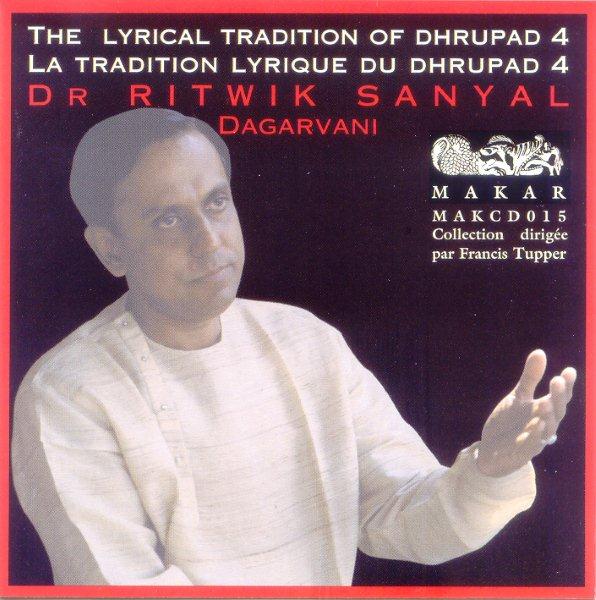
|
| nandi |
 Nov 7 2011, 10:35 PM Nov 7 2011, 10:35 PM
Post
#137
|
|
Dedicated Member  Group: Members Posts: 2565 Joined: 4-June 08 From: Illinois,USA Member No.: 55513 |
RitwickSanyal
Dr Ritwik Sanyal - Dagarvani 1. Rag Bilaskhani Todi - Alap mp3 59.82mb 43:33 192kbps 8 RAR files (Upped in 2 posts) This post has been edited by nandi: Nov 7 2011, 11:24 PM |
| nandi |
 Nov 7 2011, 11:34 PM Nov 7 2011, 11:34 PM
Post
#138
|
|
Dedicated Member  Group: Members Posts: 2565 Joined: 4-June 08 From: Illinois,USA Member No.: 55513 |
Dr Ritwik Sanyal
Dagarvani 2. Rag Bilaskhani Todi - Dhrupad - Chautal mp3 23.67mb 17:14 192kbps 4 RAR files This post has been edited by nandi: Nov 8 2011, 12:00 AM Attached image(s) 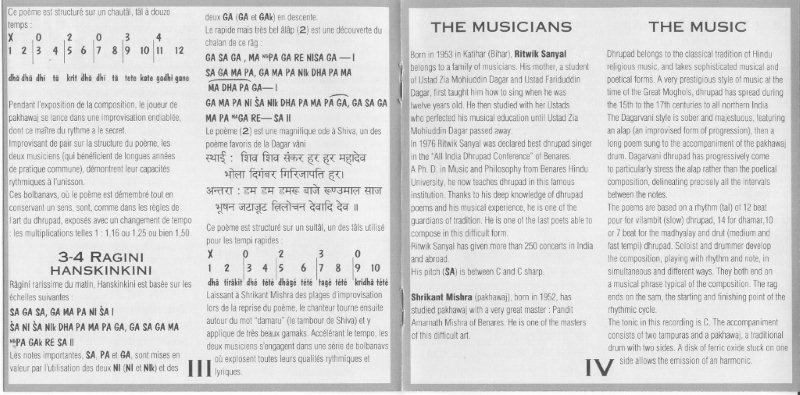
|
| sunildutta |
 Nov 22 2011, 12:49 AM Nov 22 2011, 12:49 AM
Post
#139
|
|
Newbie  Group: Members Posts: 5 Joined: 21-November 11 From: Los Angeles Member No.: 235604 |
This is probably the oldest method of Hindustani Classical music. Originally sung in temples and royal courts, it lost its eminent position to the Khayal style of singing about 2 centuries ago. Some families like the Dagars have been singing this for many generations and have preserved this style of singing. Please post as many of these as you have on this thread. There is a nice informative article at this url http://www.dhrupad.info/. The Dagar Brothers Rag Kambhoji 01_Rag Kambhoji Alap mp3 62.0mb 45:07 192kbps The size of this file is daunting and will require 2 posts. Here is an old writeup I did for Raga Records which needs some serious updating but does provide some background on dhrupad: http://www.raga.com/text/221dhrupad_text.html DHRUPAD: AN ANCIENT TRADITION by Sunil Dutta The History Dhrupad is the oldest existing form of North Indian classical music. The dhrupad tradition is a major heritage of Indian culture. The origin of this music is linked to the recitation of Sama Veda, the sacred Sanskrit text. Dhrupad is the oldest vocal and instrumental style, and the form from which Indian classical music originated. The continuity of dhrupad, a contemplative and meditative form, has been sustained by traditions of devotional music and worship. Indeed, the leading dhrupad maestros remark that rather than to entertain the audience, dhrupad's purpose is aradhana (worship). The nature of dhrupad music is spiritual, seeking not to entertain but to induce deep feelings of peace and contemplation in the listener. The word dhrupad is derived from dhruva (fixed, steadfast) and pada (word, composition). Dhrupad probably evolved from the earlier chanting of om, the sacred syllable which is claimed in Hindu canon to be the source of all creation. Om is said to have a spiritually purifying effect on the person chanting it. Later, the rhythmic chanting of the Vedic scriptures evolved into singing of chhanda and prabandha, some time in the first millennium AD. Dhrupad is said to have emerged from prabandha. One significant characteristic of dhrupad is the emphasis on maintaining purity of the ragas and the swaras (notes). According to some accounts, dhrupad was sung in temples, the singer facing the divinity. The compositions were prayers addressed to Hindu gods. Later, dhrupad evolved into a highly sophisticated and complex musical form, while still retaining its sacred character. The language of composition also changed from Sanskrit to Brijbhasha, over the period between the 12th and the 16th centuries. A major part of the compositions being sung nowadays were written in the 16th century and later. About six centuries ago, dhrupad music came to be patronized by the royal courts and its complex rendering was directed to highly sophisticated royal audiences. Among other topics, a number of compositions were written in praise of emperors. However, the sacred nature of dhrupad survived and even in the 20th century we are fortunate enough to hear this majestic form of music as performed more than 500 years ago in the royal courts of the emperors and kings of India. The Music Dhrupad music has two major parts (each of the two parts is further subdivided into several), alap and dhrupad. Alap is sung without words and dhrupad (also called bandeesh, the fixed composition part) is sung with the accompaniment of a pakhawaj, a two-headed barrel-shaped drum. A vocal dhrupad performance begins with a meditative alap in which the artist develops the raga, note-by-note, without any instrumental accompaniment except the drone of the tanpura. The emphasis is on developing each note with purity and clarity. To quote Ustad Zia Fariduddin Dagar: "Alap entails the search to get the most perfect pitch of every note. It takes you into a sort of meditation in which you are lost in the waves of sound and forget everything. There remains only sound." The alap begins very slowly and the tempo gradually increases. The alap comprises the major part of the performance. It uncovers the personality of the raga. The contemplative music surrounds and absorbs the audience. The alap evokes a mood in the audience that coincides with the mood of the raga that is chosen.The singer uses certain syllables (om, num, re, ri, na, ta, tom) that have a peaceful and meditative effect. These syllables are taken from a mantra and denote various Hindu gods. The philosophy behind not using words is that words may distract and thus lessen the chance of floating in a spiritual plane. Without the distraction caused by words, what one hears in the alap is the sound of pure music, ideally leading to divine fusion. The artist concludes the alap after exploring the three octaves and the limits of the raga being sung through improvisation. Then follows the bandeesh, a traditional composition set to a Brijbhasha text followed by composed and improvised variations, accompanied by pakhawaj. Generally the dhrupad compositions are sung in chautal (a 12 beat rhythm cycle). Other tala cycles that are used are sula tala (10) and tivra tala (7 beats), and dhamar (14 beats). The meaning of text in composition is very important and the artists must pay careful attention to the enunciation of words. Even during improvisation, care is taken not to mispronounce the words. The singer and pakhawaj player engage in a lively dialogue, but do not attempt to compete with each other. The Guru-Shishya Parampara of Oral Teaching The teaching of dhrupad is very closely tied to the ancient system of guru-shishya parampara (the teacher-disciple tradition). This is an oral tradition that dates back thousands of years. The students lived in the home of their guru and devoted themselves to riyaz (practice) of music. The lives of students were focused on learning music and helping with the household chores of their teacher. The teacher could supervise the students all the time and provide guidance. The music was taught orally, with teacher singing a phrase and students repeating it until they perfected it. The learning of dhrupad music does not involve transcribing the teaching. The leading dhrupad teachers strongly believe, as did their ancestors, that learning of music is not possible through text books. Due to its strict adherence to purity, learning dhrupad is very difficult. It takes years of rigorous and painstaking practice, involving many hours (8 to 12) of singing every day, before a dhrupad student can reach a stage when he will be ready to perform competently. These early years of total devotion to learning also mean total financial dependence, as the student does not have the time to earn a living. In the past, the teacher took care of the needs of students, so that they could commit themselves completely to the study of music. The guru, in turn, was provided for by the royal court. This royal patronage led to the preservation of guru-shishya parampara for centuries, until the abolition of the princely states in India in 1947. In effect, the disappearance of the royal system also led to a decline in the support for dhrupad music. Great artists were suddenly faced with financial hardship and were left with no support. The guru-shishya parampara was severely impacted by this turn of events. The central and state governments in India are belatedly making limited efforts to revive this tradition. The Dhrupad Kendra in Bhopal, based on this ancient tradition, has produced several outstanding vocalists. However, much additional work needs to be done to ensure the survival of this ancient tradition, an intrinsic part of the culture of India. As the guru-shisya parampara depends upon oral transmission of information, if there is no one to transfer the information, the musical tradition, that is thousands of years old, might simply disappear. The Banis During the seventh century, five geetis (styles of singing) were mentioned by Matang. These geetis, called Shuddha, Bhinna, Gauri, Vegswara, and Sadharani were supposed to have developed later into the four banis (or vani) of dhrupad: Gauhar, Khandar, Nauhar, and Dagarvani. Historians have not bee able to resolve the questions related to the genesis or even the existence of the banis, due to a lack of documentation. The style of singing by Darbhanga and Talwandi Gharanas is said to be derived from khandar vani. Asad Ali Khan, the rudra vina maestro, states that his family practices Khandar vani. The family of Indra Kishore Mishra claims to be the practitioner of Nauhar and Khandar vani. The Dagar family practices Dagarvani bani. Prominent Dhrupad Gharanas Today: The Dagar Family The Dagar family claims lineage through Swami Haridas (fifteenth century), a renowned singer of that time. Besides Swami Haridas, Behram Khan (1753-1878) was the most renowned dhrupad artist in the Dagar clan. He was associated with the royal court of Jaipur. Other famous artists were Ustad Zakiruddin Khan (1840-1926) and Allabande Khan (1845-1927), well known for their jugalbandi (duet) performances. The famous Dagar brothers are the grandsons of Allabande Khan, whereas Ustad Zia Fariduddin Dagar and Ustad Zia Mohiuddin Dagar are the grandsons of Zakiruddin Khan. The Dagarbani dhrupad rendition is characterized by meditative and leisurely development of alap. The purity of a raga is never compromised for the sake of showmanship, often observed in many other Hindustani music concerts in recent times. Even during the singing of the composition, with intricate rhythmic patterns, the music maintains its spiritual character. The biographical details of the musicians of the past are very sketchy, partly due to the oral tradition of passing information. The available information is largely anecdotal and unauthenticated, especially when it comes to tracing the genealogy of the gharana (musical tradition) systems. The history of the Dagar family (Dagar Gharana, or tradition) can be authentically traced to the 1800s, although contemporary historians believe that Dagar family has been associated with Dhrupad for twenty unbroken generations. It is accepted universally that the Dagar family has contributed significantly to preservation and spreading of Dhrupad. They have helped keep this art alive, even though this music was losing popularity in a time of changing tastes. A unique and interesting fact about the Dagar Gharana is that unlike most of the gharanas of North Indian classical music, it claims no connection with the legendary Tansen. Talwandi Gharana The Talwandi tradition is associated with the western parts of India, specifically, Punjab. Presently, the tradition has very few singers, all living in Pakistan. Prominent singers of the tradition include Muhammad Hafiz Khan and Muhammad Afzal Khan. Hafiz Khan claims that the Talwandi gharana represents Khandar bani. Dilip Chandra Vedi, who learnt from Talwandi Gharana members in the 1920s, claimed that Nayak Chand Khan and Suraj Khan were the founders of Talwandi Gharana. Contrary to other opinions regarding dhrupad, Hafiz Khan places Islam at the center of dhrupad philosophy. The mantra sung by him during the alap is "nita tarana tarana Allah (Almighty in Islam) tero nam." The Talwandi Gharana appears to have similarities to the Darbhanga Gharana described below. A few recordings exist that show extremely fast concluding portions of the alap. The compositions display highly complex rhythmic variations. Darbhanga Gharana Darbhanga tradition is one of the two main living Dhrupad gharanas, besides the Dagar tradition. The Mallik family represents Darbhanga Gharana of dhrupad. Radha Krishna and Karta Ram, the court musicians for the Nawab of Darbhanga, are considered the founders of the tradition. A link to the musical line of Tansen is traced through Bhupat Khan, the teacher of the founders of the family. The performance of the Darbhanga Gharana of dhrupad singers can be distinguished mainly by the way compositions are sung after the alap. A major emphasis is placed on the rhythmic aspect of the singing. According to Abhaya Narayan Mallik, the Darbhanga tradition is associated with Gauhar Bani. The family has a rich stock of compositions to draw upon. Prominent singers include the late Ram Chatur Mallik, Vidur Mallik, Abhaya Narayan Mallik, and Prem Kumar Mallik. Bettiah Gharana According to Falguni Mitra, the main proponent of Bettiah Gharana, Bettiah Gharana has compositions available from all the Vanis, though more emphasis is placed on Khandar Vani. The ornamentations and rhythmic variations are strictly applied during the rendition of dhrupad. He states that the gharana originated in the royal state of Bettiah in Bihar. Pyar Khan of Seni Gharana and Haider Khan are considered to be the major influence on this gharana. Dhrupad Music in the 20th Century and Beyond During the early part of the 20th century, there was a loss of popularity for Dhrupad, and it appeared that this musical tradition and the part of Indian culture that it represents might die very soon. One of the reasons was the loss of royal patronage and the subsequent financial hardships faced by the artists. The alap singing and the improvisation involved in dhrupad requires enormous training, talent, imagination and creativity. This in turn requires dedication and focus on the part of the learner if he or she wants to become an accomplished artist. The great dhrupad singers emphasize that their arduous training lasting decades before they could master the art and its intricacies. Dhrupad music has survived so far, due to the persistence and dedication of the masters who have not given up, despite financial hardships and adversity. This persistence seems to be coming to fruition now, as we see a new generation of dhrupad artists such as Wasifuddin Dagar, Bahauddin Dagar, Gundecha Brothers, Nancy Lesh, Uday Bhawalkar, Prem Kumar Mallik, and others. - © 1999 Sunil Dutta |
| sunildutta |
 Nov 22 2011, 08:57 AM Nov 22 2011, 08:57 AM
Post
#140
|
|
Newbie  Group: Members Posts: 5 Joined: 21-November 11 From: Los Angeles Member No.: 235604 |
The Dagar Brothers 02_Rag Kambhoji - Dhrupad in praise of Krishna mp3 24.57mb 17:53 192kbps 4 RAR files Here is an old writeup about dhrupad music: http://www.raga.com/text/221dhrupad_text.html I will attach a masterpiece by the elder Dagar Brothers (Moinuddin and Aminuddin Dagar) singing kamboji. |
| nandi |
 Nov 23 2011, 10:22 PM Nov 23 2011, 10:22 PM
Post
#141
|
|
Dedicated Member  Group: Members Posts: 2565 Joined: 4-June 08 From: Illinois,USA Member No.: 55513 |
Girish Karia
Nathdwara Haveli Dhrupad 01. Rag Bhairav - Manla Charan mp3 2.10mb 1:31 192kbps Girish Karia Nathdwara Haveli Dhrupad 02. Rag Bhairav - Stuti - Adital mp3 6.43mb 4:441 192kbps Girish Karia Nathdwara Haveli Dhrupad 03. Rag Vibhas - Dhrupad - Vilambit Chautal mp3 8.22mb 5:59 192kbps Attached image(s) 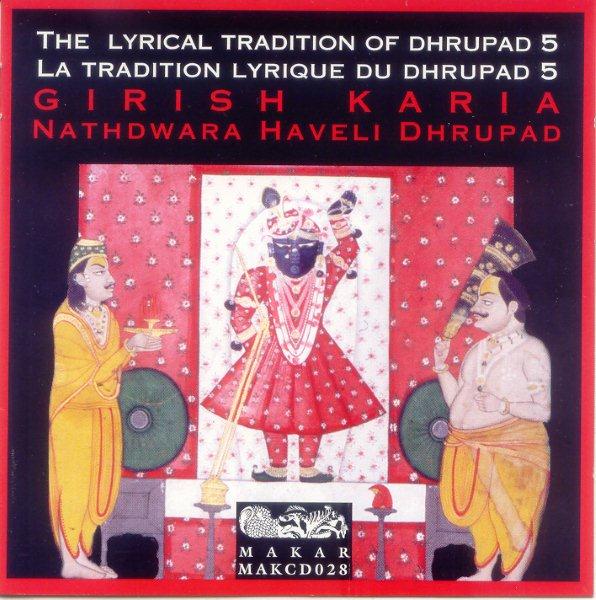
|
| nandi |
 Nov 23 2011, 10:40 PM Nov 23 2011, 10:40 PM
Post
#142
|
|
Dedicated Member  Group: Members Posts: 2565 Joined: 4-June 08 From: Illinois,USA Member No.: 55513 |
Girish Karia
Nathdwara Haveli Dhrupad 04. Rag Asavari - Dhamar mp3 6.82mb 5:59 192kbps Girish Karia Nathdwara Haveli Dhrupad 05. Rag Bilawal - Dhamar mp3 6.67mb 4:51 192kbps Girish Karia Nathdwara Haveli Dhrupad 06. Rag Malkauns - Charchari Tal mp3 9.84mb 7:09 192kbps |
| nandi |
 Nov 30 2011, 03:56 AM Nov 30 2011, 03:56 AM
Post
#143
|
|
Dedicated Member  Group: Members Posts: 2565 Joined: 4-June 08 From: Illinois,USA Member No.: 55513 |
Girish Karia
Nathdwara Haveli Dhrupad 07. Raag Sarang_Vilambit Chautal mp3 10.0mb 7:19 192kbps Girish Karia Nathdwara Haveli Dhrupad 08. Rag Gauri - Adi Tal mp3 6.447mb 4:42 192kbps Girish Karia Nathdwara Haveli Dhrupad 09. Rag Kedar - Ras - Madhyalay Chau Tal mp3 5.94mb 4:19 192kbps This post has been edited by nandi: Nov 30 2011, 03:56 AM Attached image(s) 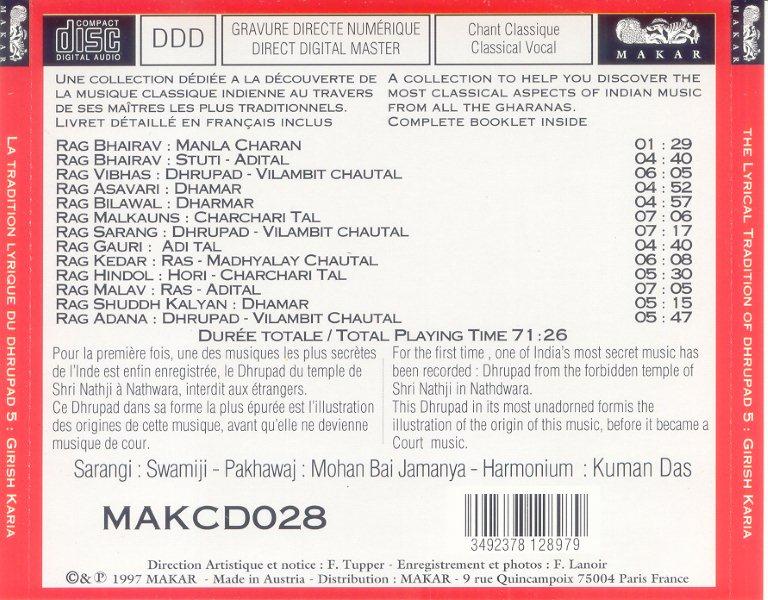
|
| nandi |
 Nov 30 2011, 04:12 AM Nov 30 2011, 04:12 AM
Post
#144
|
|
Dedicated Member  Group: Members Posts: 2565 Joined: 4-June 08 From: Illinois,USA Member No.: 55513 |
Girish Karia
Nathdwara Haveli Dhrupad 10. Rag Hindol - Hori - Charchari Tal mp3 7.56mb 5:30 192kbps Girish Karia Nathdwara Haveli Dhrupad 11. Rag Malav - Ras - Adital mp3 9.77mb 7:06 192kbps Girish Karia Nathdwara Haveli Dhrupad 12. Rag Shuddh Kalyan - Dhamar mp3 7.24mb 5:16 192kbps This post has been edited by nandi: Dec 3 2011, 01:47 AM Attached File(s)  Girish_Karia.txt ( 1.63 k )
Number of hits: 1
by members
Girish_Karia.txt ( 1.63 k )
Number of hits: 1
by members |
| nandi |
 Nov 30 2011, 04:20 AM Nov 30 2011, 04:20 AM
Post
#145
|
|
Dedicated Member  Group: Members Posts: 2565 Joined: 4-June 08 From: Illinois,USA Member No.: 55513 |
Girish Karia
Nathdwara Haveli Dhrupad 10. Rag Hindol - Hori - Charchari Tal mp3 7.56mb 5:30 192kbps Girish Karia Nathdwara Haveli Dhrupad 11. Rag Malav - Ras - Adital mp3 9.77mb 7:06 192kbps Girish Karia Nathdwara Haveli Dhrupad 12. Rag Shuddh Kalyan - Dhamar mp3 7.24mb 5:16 192kbps Girish Karia Nathdwara Haveli Dhrupad 13. Rag Adana - Dhrupad - Vilambit Chautal mp3 7.97mb 5:48 192kbps |
| nandi |
 Dec 3 2011, 12:27 AM Dec 3 2011, 12:27 AM
Post
#146
|
|
Dedicated Member  Group: Members Posts: 2565 Joined: 4-June 08 From: Illinois,USA Member No.: 55513 |
Uday Bhavalkar
Dagarvani 1. Rag Gurjari Todi - Alap mp3 16.12mb 11:44 192kbps 3 RAR files Attached image(s) 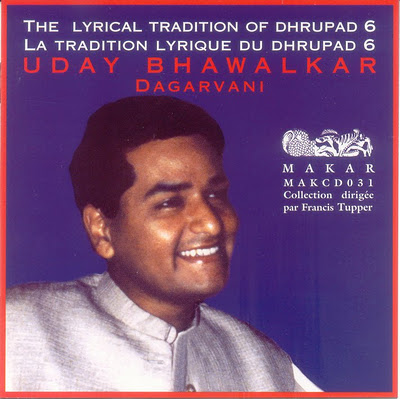
|
| nandi |
 Dec 3 2011, 12:36 AM Dec 3 2011, 12:36 AM
Post
#147
|
|
Dedicated Member  Group: Members Posts: 2565 Joined: 4-June 08 From: Illinois,USA Member No.: 55513 |
Uday Bhavalkar
Dagarvani 2. Rag Gurjari Todi - Jor mp3 14.63mb 10:39 192kbps 2 RAR files This is an extremely compelling performance, with powerful command and a wide range of nuance. It was quite eye-opening to me, and shows some of the ideas of Uday Bhawalkar's teacher Z.M. Dagar, yet in an overall style beginning to take on its own originality. Although not a Dagar per se, Bhawalkar (taught by Z. Fariduddin Dagar after Z.M. Dagar's death) is extremely impressive here. Uday Bhawalkar (b.1966) certainly makes one feel confident in the future of dhrupad, as he is obviously blessed with great talent. Born in 1966 at Jaora (M. P.) in family of musicians, Uday Bhawalkar has studied classical singing since he was 8 years old. After the cursus of the music school of Ujjain, he received the Allauddin Khan Sangeet Academi Grant and became the student of Fariduddin Dagar in Bhopal. Since 1985 and until his death, the great master Zia Mohiuddin Dagar (rudraveena) has taught him the dhrupad of the Dagarvani. In 1987 he received the National Grant for Dhrupad, then the Gold Medal of Dhrupad from the hands of Aminuddin Dagar (The Dagar Brothers). He gave his first concert in Bhopal in 1985. He has toured a lot in India in very famous festivals ("Tansen Samaroh" of Gwalior, "Dhrupad Samaroh" of Bhopal, "Amir Khan Samaroh" of Indore...) and in Europe ("Masters of the Raga" in Holland "Otono Music Festival" in Spain, "Sangeet Parampara Festival" in Berlin). In 1988 he became an artist of All India radio. Manik Munde (pakhwaj), born in 1960, has studied pakhwaj from a very great master : Pt Amarnath Mishra from Benares. He is a known instrumentist in India. 1. Rag Gurjari Todi - Alap 2. Rag Gurjari Todi - Jor 3. Rag Gurjari Todi - Jhala 4. Rag Gurjari Todi - Dhrupad - Sul Tal 5. Rag Gurjari Todi - Dhrupad - Tivra Tal Uday Bhawalkar - vocals Manik Munde - pakhawaj This post has been edited by nandi: Dec 3 2011, 01:48 AM |
| nandi |
 Dec 3 2011, 12:46 AM Dec 3 2011, 12:46 AM
Post
#148
|
|
Dedicated Member  Group: Members Posts: 2565 Joined: 4-June 08 From: Illinois,USA Member No.: 55513 |
Uday Bhavalkar
Dagarvani 3. Rag Gurjari Todi - Jhala mp3 20.06mb 14:36 192kbps 3 RAR files This post has been edited by nandi: Dec 3 2011, 12:47 AM Attached image(s) 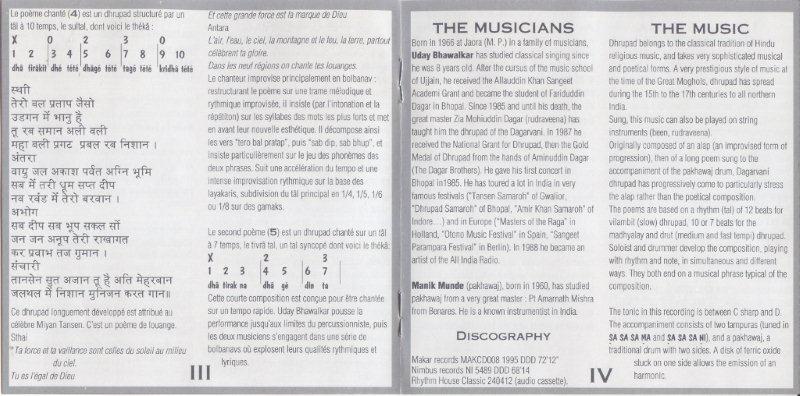
|
| nandi |
 Dec 3 2011, 01:00 AM Dec 3 2011, 01:00 AM
Post
#149
|
|
Dedicated Member  Group: Members Posts: 2565 Joined: 4-June 08 From: Illinois,USA Member No.: 55513 |
Uday Bhavalkar
Dagarvani 4. Rag Gurjari Todi - Dhrupad - Sul Tal mp3 27.97mb 20:22 192kbps 4 RAR files Attached image(s) 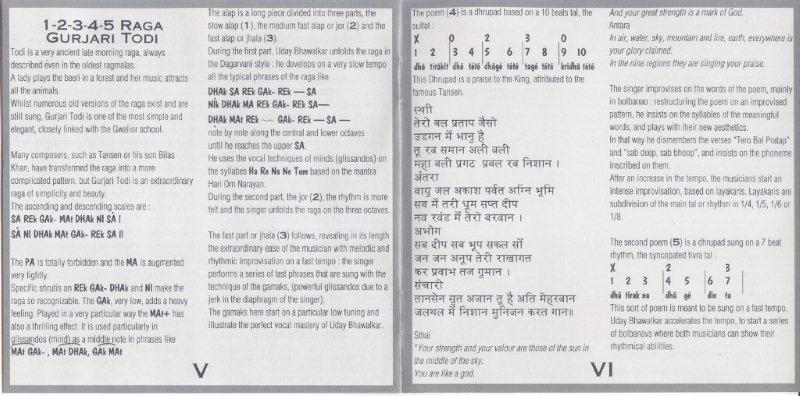
|
| nandi |
 Dec 3 2011, 01:07 AM Dec 3 2011, 01:07 AM
Post
#150
|
|
Dedicated Member  Group: Members Posts: 2565 Joined: 4-June 08 From: Illinois,USA Member No.: 55513 |
Uday Bhavalkar
Dagarvani 5. Rag Gurjari Todi - Dhrupad - Tivra Tal mp3 12.91mb 9:24 192kbps 2 RAR files Attached image(s) 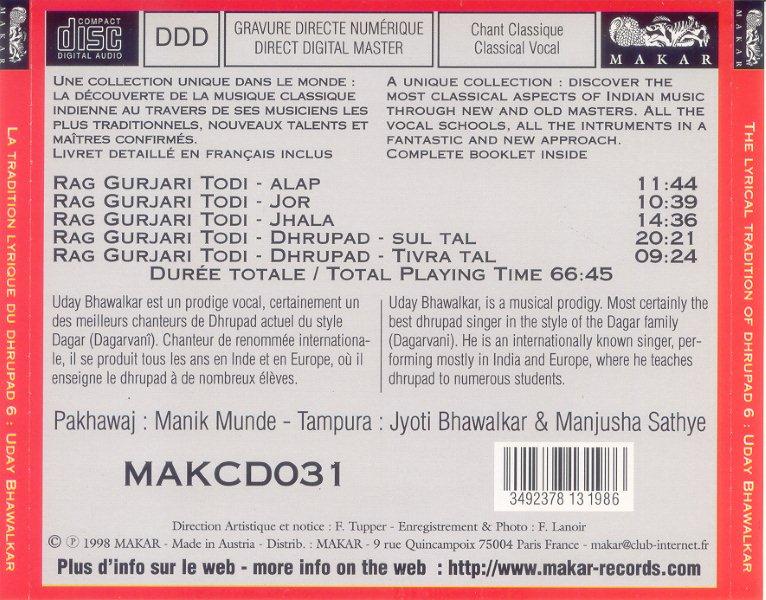
|
  |
1 User(s) are reading this topic (1 Guests and 0 Anonymous Users)
0 Members:

|
Lo-Fi Version | Disclaimer | HF Guidelines |  |
Time is now: 28th April 2024 - 11:35 PM |
Invision Power Board
v2.1.7 © 2024 IPS, Inc.
Licensed to: Hamaraforums.com









